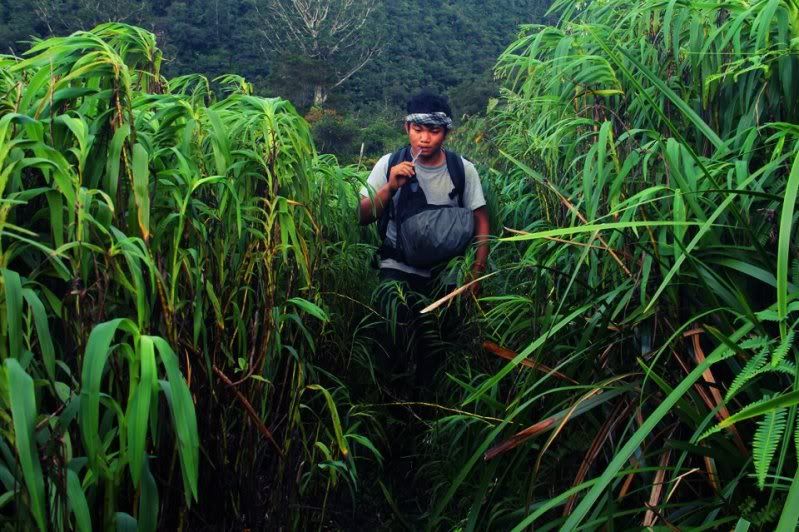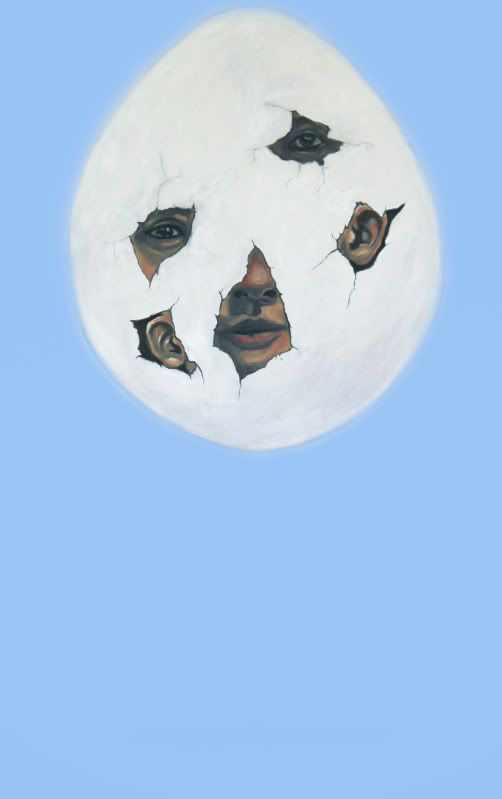Tuesday, May 22, 2012
 5:07 AM |
The Visualist of Common Sense
5:07 AM |
The Visualist of Common Sense
Part 9 of the Dumaguete Design Upstarts Series
Looking at the paintings of Paul Benzi Florendo, one immediately recalls the raw power of the works of the young Jutze Pamate or Mark Valenzuela or Razceljan Salvarita—all of earnestness and strangeness and sureness of vision that mark what may be the beginning of a fantastic career in the visual arts, right at its rawness, without strings or politics or life’s hard bargains. To look at Benzi’s paintings and see how they pulsate is to quicken once more life from the tired old critical bones, slaying the old pronouncements that “visual art in Dumaguete is dead.”
It’s certainly not.
That it is in some sort of doldrums may be something that cannot denied. But there are others like Benzi springing from an increasingly bustling art scene in Dumaguete. (That is, if “bustling” is the word.) Collectively, they constitute some hope, enough for the city to recall its prime as Visayan capital of art. The most exciting among them include Stephen Abanto, Nabil Padilla, Jess Andrew Abode, Sabrina Skye Benito, Kristine Jul Oliva, Ramon Adonis Catacutan, and Hans de Barras—and in their last group show together, for the
Third Horace B. Silliman Art Exhibit held last March, some showed a brilliant command of the artistic that went beyond the pale of the expected and the humdrum: I remember a guitar stripped, dismantled, reset, and transformed into a kind of Rorschach test; a series of still lives and what-not—a snake with a gun among them—that seemed to put some strange edginess into the representational; a set of skulls from different sorts of material that put a hint of danger to the domestic; an installation of clay and wire figures “at play” with kites that married wit with the whimsical. These were fantastic pieces by some of the city’s young artists, and one could only wish to see more of what they could do beyond plates made for classroom exercises, beyond the requisite demands of academic exhibitions. That most have not entirely burst out of their confines and rocked the city beyond the comforts of campus life is a little beyond my ken—but perhaps they are only cocooning?

Paul Benzi Florendo
Enter Paul Benzi Florendo. A few months ago, in the makeshift exhibition walls of Canto Fresco, which is owned by the visual artist Babu Wenceslao, he debuted with his first solo exhibition—something he called
What Ya Think? The show, small though it was, featured ambitious art with a nod to the soft, strangely tender (if also unsettling) surrealism of René Magritte—but with wit completely Mr. Florendo’s own. There’s the blue teddy bear with the old man’s face, dragging a toy cart with square wheels, in diagram; there’s the masked boy astride a snail, bullhorn in hand; there’s the similarly bullhorned girl, eyes masked or pixelized, riding a giant rabbit; there is the army of boxy androids with human faces, minus the eyes, deep in empty thought-balloons; there’s the strapping youth with the baseball cap, looking up into the rainbowed sky, boxed in by some invisible diagram that include a hovering satellite… It is all very strange, and all made to make you ask—“What do you think?” The question is subtly provocative, and asks much of the viewer in terms of what they put
into the pictures.
It is the painting “Egghead” that strikes me the most though. It shows a gigantic egg hovering in an emptiness of azure, cracked in places, and through the bigger holes punched by the cracks, we see various parts of a human face—nose, lips, ears, eyes—asymmetrical, disembodied, and whole at the same. And all that, afloat, like a beautiful threat.
What do you think?

Egghead by Paul Benzi Florendo
“I always want to make people think hard when viewing my works,” Mr. Florendo explained. “I do not want the audience to just see my painting and think, ‘Oh, it’s nice,’ or conversely, ‘Oh, that’s stupid’—and just stop there. I want them to recognize something beyond what is obvious. I want them to perceive how I see life or how I tell a story of moments through my paintings—and perhaps relate these to their own lives.”
But what he also wants is a workout of sorts for his potential viewers. “I want them to feel as if their brains are going to burn up trying to think too much,” he said, “or perhaps even ultimately explode, especially when they realize that too much thinking did not have to done in the first place. I want people to be able to also use plain common sense, which is rare these days. I want to spark creativity in my viewer’s minds, and perhaps cause them to be artistic in their own ways.”
Which is perhaps putting too many eggs of expectations in one basket, but one admires that ambitious reach in the young artist: to seize that fabled opportunity to reach into the minutiae of a viewer’s head, and transform thinking through art.
What do you think?
But regardless of my mention of Magritte, Mr. Florendo does not claim to have influences in the way he marks his art. He reaches out, instead, to the common “influence” of what surrounds him: “My influences are the people around me doing what they normally do,” he said. “May it be wiping the table, playing in an orchestra, taking photos, typing on a keyboard, chewing gum, snoring, running, giving a sermon—you name it, these simple things give me a lots of ideas that can certainly be turned into something artistically complex. It’s like a simple cycle: I take ideas from what I see around me, then I give it back to the world through my paintings.”
And if this indeed is a start of something bigger, artistically speaking, what does the future entail for him? “I always wanted to do work which many people can relate to, or at least that they will be blessed by my work. But something I have always wanted to do is make people interact with my art in certain ways.” But it is that first wish for relatability that he wants the most. “I hope to achieve something big which people around me can recognize and be able to relate to. Even the simplest of people.”
Which makes common sense.
Labels: art and culture, dumaguete
[0] This is Where You Bite the Sandwich
GO TO OLDER POSTS
GO TO NEWER POSTS

















 5:07 AM |
The Visualist of Common Sense
5:07 AM |
The Visualist of Common Sense

